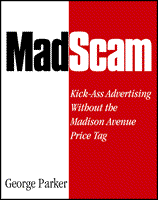 “People don’t read advertising – they read what they are interested in. And sometimes, it happens to be ads.”
“People don’t read advertising – they read what they are interested in. And sometimes, it happens to be ads.”
– Howard Gossage
George Parker ‘s very strong opinions on advertising are detailed in his latest book (subtitled “Kick-Ass Advertising Without the Madison Avenue Price Tag”). He rants about the way businesses generally do advertising, what’s wrong, and how to do much better (without spending a lot).
First, if your business foundation isn’t strong (poor quality of service or product), fix it. Spending time and money to create an ad only to have more people dissatisfied by your business isn’t a good idea.
To create a good (or great) ad, you need three things: information (your unique selling/value proposition – USP/ UVP), time (to craft), and money (to spread the message).
Some of his questions to help you craft your USP/UVP include:
- Are you unique?
- Can you positively prove it?
- If you’re not unique, are you better at what you do than the competition?
- Do you provide provable quality?
- Do you provide value?
- Are you totally reliable?
- Do you give the impression you’ve been around for a while?
- Do you have solid and reference-proof case studies?
- If you went out of business tomorrow, would anyone, apart from you, your mother, your dog, and your investors care?
“The consumer isn’t stupid, she’s your wife.”
– David Olgilvy
Great ads aren’t full of clich?©s or say “me-too”. They are edgy ads full of true, useful information (USP/UVP) about your product (or service). They are well targeted. The standard axiom of “it takes 7 impressions to get noticed” are baloney – all it takes is one great ad to get noticed, and hammering a dumb message over and over is insulting to the reader.
Besides discussing when it’s appropriate to create print, radio, television, and online advertisements, he tells how (and who) should create the ads. He’s not a fan of doing it yourself with in-house talent; he strongly believes that you should almost always use a consultant / freelancer (like himself). When creating ads, use “tissue sessions”: a simple idea is shown and you brainstorm the contents with the ad-creating talent.
“I know that half of the money I spend on advertising is wasted.
Unfortunately, I don’t know which half.”
– John Wanamaker
He concludes that you must measure the result of your advertising. When someone new contacts you ask, “Where did you hear about us?”. Use tracking codes or special ad-specific offers to help isolate which ads produced which results. Without measuring, you have no clue if you’re wasting half your money (or more).


 Ida, my Prussian grandmother, loved talking with friends and family.
Ida, my Prussian grandmother, loved talking with friends and family.